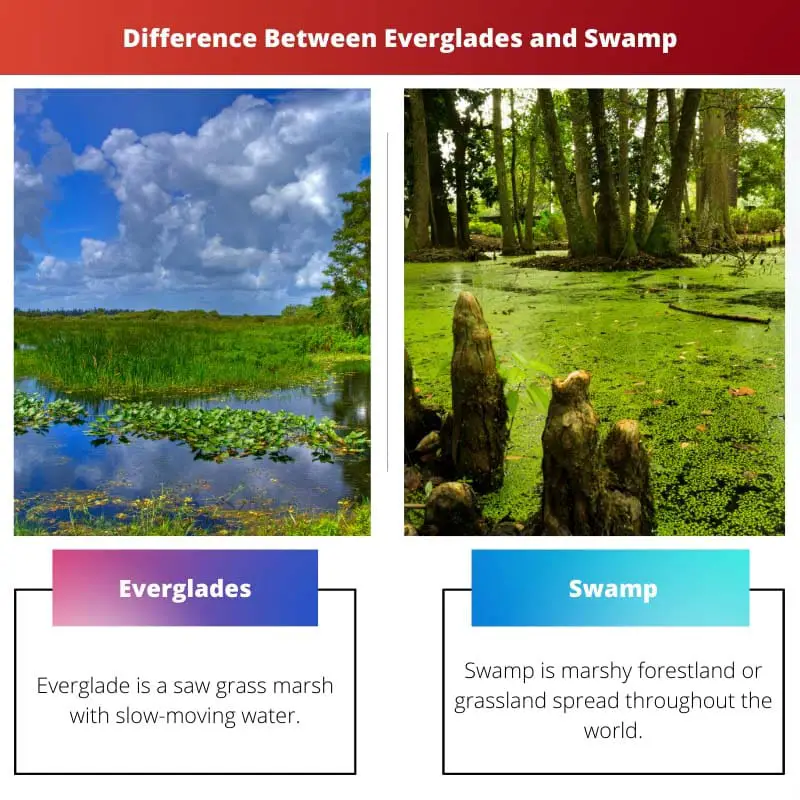The term ‘marshland’ is used to define huge areas of muddy wetland or grassland. Everglades and Swamps are important types of marshland. Everglade is muddy marsh saw grasslands, whereas swamp areas are marshlands with stable waterbody.
Everglades can be converted into agricultural land, but swamps cannot be.
Key Takeaways
- The Everglades is a specific wetland ecosystem in Florida, while swamps are a wetland characterized by slow-moving water and forested vegetation.
- The Everglades contain diverse habitats such as sawgrass marshes, mangrove forests, and pine rocklands, whereas trees and shrubs dominate swamps.
- The Everglades supports various species, including the American alligator, the Florida panther, and the American crocodile. At the same time, swamps can host various animals depending on their location and climate.
Everglade vs Swamp
The Everglades is a natural tropical wetland region in southern Florida, United States. A swamp is a type of wetland characterized by standing water and a high density of trees and other vegetation, it comes in many different varieties, from freshwater swamps to saltwater swamps.

Everglade is confined to the South Florida region. And muddy area enclosed in the slow-flowing river with saw grass. These areas are the transition of wet, subtropical, and warm climates. Also, the composition has calcium carbonate and shells.
Everglade is full of biotic vegetation, and flowing water maintains the oxygen balance.
A swamp is a wet grassland, the transition between water and land. Also, the sea environment is shallow vegetation and soil saturation too. The swamp soil contains groundwater, precipitation, freshwater flooding, or tides.
The water flow maintains the nutrients and pollutant balance, whereas the excess material remains at the bottom.
Comparison Table
| Parameters of Comparison | Everglade | Swamp |
|---|---|---|
| Definition | Everglade is a saw grass marsh with slow-moving water. | Swamp is marshy forestland or grassland spread throughout the world. |
| Water | Slow-moving water is present. | Stagnant water is present |
| Key Feature | Saw grass marsh is the key feature. | Grassland or Forestland is the key feature. |
| Area | Area limited to Southern Florida. | Spread throughout the world. |
| Size | Everglade has a huge area covered. | The swamp area may vary from smaller areas to larger ones. |
What is Everglade?
Everglades may be defined as a huge area of muddy marshlands or grassland. Also, Everglade is mostly used for the Southern Florida region. These areas contain saw grass and slow-flowing water.
The weather of South Florida is largely a transition between the subtropical and tropical climates. Everglade areas can be converted into agricultural land, and sugarcane is the main crop.
Also, more than half of the land is now converted into farmland and urban usage.
Furthermore, nowadays, these are under threat of extinction and environmental barrier. There is a huge fluctuation in the weather pattern of the Everglades.
This change in pattern ranges from periodic flooding in the wet season to drought conditions in the dry season. Many valuable metals and alloys are found in Everglade. These include limestone, quartz, and much more.
The deposition of calcium is present in the sediment soil. This sediment soil is mostly present in the area where the water level rise and fall are frequent. This rise occurs due to the occurrence of rainfall.
These everglades are converted to agricultural land in most of the South Floridian region.

What is Swamp?
Swamp areas are wet and muddy forestland. Swamps are further categorized depending on the water. These are namely freshwater and seawater swamps.
Freshwater swamps are found around the lake or river. Also, these are dependent on seasonal rainwater and natural flooding. In contrast, Saltwater swamps are present beside tropical and subtropical coastlines.
The swamp can be subdivided into a true and transition swamp. A true swamp contains forest, and a transition swamp consists of shrubs. The vegetation of the swamp mainly depends on oxygen, nutrients, water pH, and toxicity.
Swamps are one of the important factors in flood management.

Main Differences Between Everglade and Swamp
- Everglade has a slow-running flow of water. On the other hand, the swamp has steady or stagnant water.
- Everglade is confined to the southern region of Florida. In contrast, the swamp is spread throughout the world.
- Everglade has a wide variety of habitats, flora and fauna. On contrary to this, swamp vegetation depends upon the climate condition and habitat.
- The weather pattern in the Everglades range from drought to flooding conditions. However, the swamp has a constant climate depending upon the country’s climate.
- Everglades can be converted into farmland with sugarcane as a major crop. Also, the swamp has forestland that has bushes, shrubs and herbs.

Reference
- https://www.jstor.org/stable/4075287
- https://link.springer.com/article/10.1007/s10646-008-0233-x
- https://academic.oup.com/bioscience/article-abstract/61/1/49/304606
- https://www.worldscientific.com/doi/abs/10.1142/9781848160125_0014

The detailed comparisons between Everglade and Swamp are helpful for understanding their distinctions. The information is well-researched and presented.
The article presents compelling information on Everglades and Swamps, providing a clear distinction between the two types of wetlands. The conclusions are well-supported by the data.
The comparison table provides a concise summary of the main differences between the Everglade and Swamp. It is a useful tool for quick reference.
The article offers an insightful overview of the Everglade and Swamp, addressing their environmental significance. It is an excellent resource for educational purposes on ecological systems.
The article provides a very clear comparison of the Everglade and Swamp, highlighting their differences in detail. It is a valuable read for anyone interested in wetland ecosystems.
This is a very informative article, and does a good job of explaining the differences between the two types of wetlands. It’s a great resource for people who are interested in environmental science.